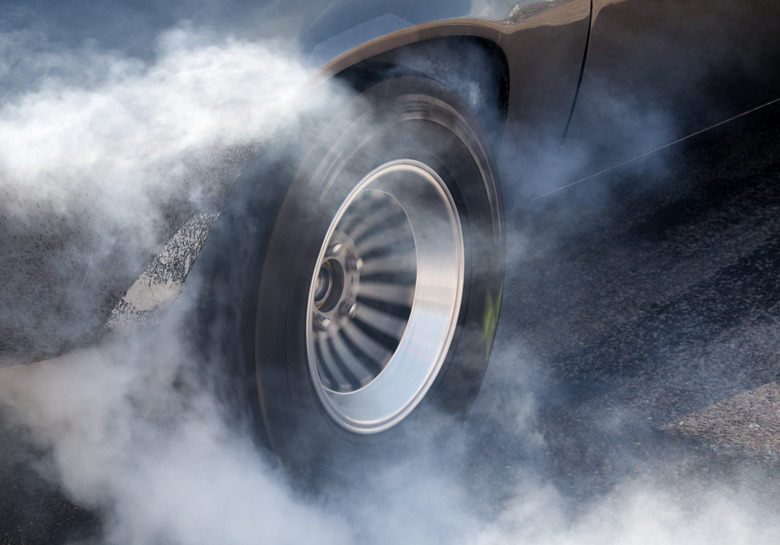How To Convert Horsepower To Miles Per Hour
Horsepower is a unit of power, and miles per hour is a unit of speed. Physics tells us that power and speed (or velocity) are related by the the equation Power = Force • Velocity. According to this relationship, all we need to know is the force exerted on a body to be able to convert between its power and the speed it travels. However, force, also known as thrust, isn't always easy to determine. One way to do it is to measure the object's mass, do an acceleration test and apply Newton's Second Law.
What Is Horsepower?
What Is Horsepower?
The term "horsepower" was introduced by James Watt, an early developer of the steam engine. He coined the term to measure the power of a machine, or the amount of work it was capable of doing in a given amount of time. In physics, work is the amount of force required to move an object a certain distance. Based on his observation of horses, Watt defined one horsepower as 33,000 foot-pounds/minute, or 550 foot-pounds/second. In the metric system, the unit of power is the watt, which is named after Watt, and 1 horsepower is equal to 746 watts or 0.746 kilowatts.
Measuring Force
Measuring Force
You might be interested in how fast a car with an engine that develops a certain amount of horsepower can go, but you can only determine the relationship between power and speed on a case-by-case basis. That's because the value for force that you need to plug into the equation relating power and speed depends the weight of the car as well as on how fast the car accelerates. These are variables. To illustrate, let's do an example with a 2017 Maserati GranTurismo coupe, which has a curb weight of 4,145 lbs. and a V8 engine that develops 454 horsepower.
To measure force – or thrust – you first have to find the mass of the car. When you weigh it, you don't actually get the mass, but the weight, which is the mass multiplied by the acceleration due to gravity, which is 32/feet/second2. If you measure the weight in pounds, divide that number by 32 feet/second2 to get the mass in units called slugs. The mass of our Maserati is about 130 slugs.
Now it's time to do an acceleration test to find how long it takes the car to reach a speed of 60 miles per hour from a standstill. Convert that final speed to feet/second and divide it by the time it took to attain that speed. That gives you the average acceleration. Now you have all you need to find the thrust developed by the engine because, according to Newton's Second Law, Force (Thrust) = Mass • Acceleration.
Acceleration tests performed on the 2017 Maserati GranTurismo confirm that it can accelerate from 0 to 60 miles per hour (88 feet per second) in about 5 seconds. Dividing the maximum speed in feet per second by 5 seconds, we get an average acceleration of 17.6 feet/second2. That means the engine develops (130 slugs • 17.6 ft/s2) = 2,288 pounds of thrust at full throttle.
Relating Horsepower to Speed
Relating Horsepower to Speed
You know the horsepower rating of the engine, and now you know the thrust, so you can calculate the speed the car will travel using the relationship: Speed = Power/Force. To arrive at an answer, we note that that 1 Horsepower = 550 ft.-lb./s, and the engine develops 454 HP, which is 249,700 ft.-lb./s. We divide that by the thrust calculated in the acceleration test. Accordingly, the Maserati GranTurismo should be able to travel at a speed of 109 feet/second, or a little over 74 miles per hour while developing that amount of thrust.
A Maserati actually can travel faster than 74 miles per hour; the car is known as one of the fastest – if not the fastest – cars in the world. It won't develop its top speed while developing that amount of thrust, though. Speed and force are in an inverse relationship, so reducing the acceleration, which reduces the force the engine needs to exert, increases the speed. If you own a Maserati, and you want to see how fast it really goes, be gentle on the throttle.
Cite This Article
MLA
Deziel, Chris. "How To Convert Horsepower To Miles Per Hour" sciencing.com, https://www.sciencing.com/convert-horsepower-miles-per-hour-2802/. 13 March 2018.
APA
Deziel, Chris. (2018, March 13). How To Convert Horsepower To Miles Per Hour. sciencing.com. Retrieved from https://www.sciencing.com/convert-horsepower-miles-per-hour-2802/
Chicago
Deziel, Chris. How To Convert Horsepower To Miles Per Hour last modified March 24, 2022. https://www.sciencing.com/convert-horsepower-miles-per-hour-2802/
